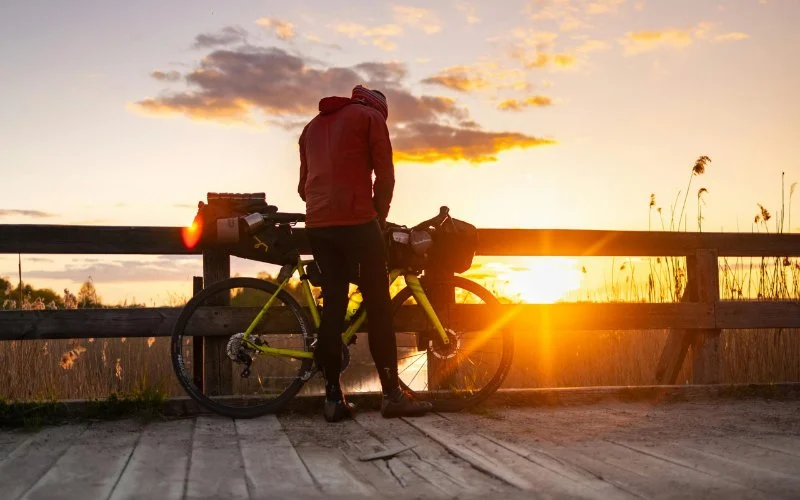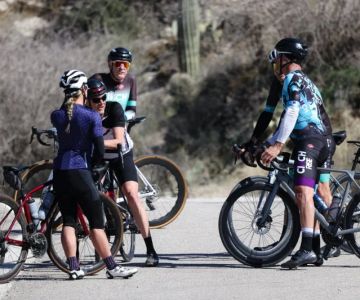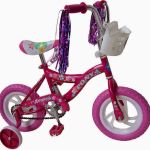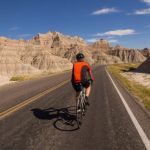
- 1-Understanding Bikepacking
- 2-Choosing Your Bikepacking Destination
- 3-How to Plan Your Bikepacking Route
- 4-Essential Bikepacking Gear You Need
- 5-Training and Preparing for Your Bikepacking Adventure
- 6-Real-Life Bikepacking Adventure: A Case Study
- 7-Shop for Bikepacking Gear at Cycling Guider
1. Understanding Bikepacking
Bikepacking is a unique and exhilarating way to explore the great outdoors. Unlike traditional cycling, bikepacking involves longer journeys where you carry all your gear with you. Whether you're planning a weekend trip or a multi-day adventure, understanding the basics of bikepacking is crucial to having a successful and enjoyable experience.
1.1 What Makes Bikepacking Different from Traditional Cycling?
While traditional cycling typically involves riding for a few hours or days while staying at hotels or lodges, bikepacking is more about self-sufficiency. You’ll carry camping gear, food, and water on your bike, and you may camp or find shelter along the way. This means you’ll need to be prepared for extended rides in remote areas, with minimal support.
1.2 Why Bikepacking is a Great Adventure
Bikepacking combines the freedom of cycling with the thrill of adventure. It’s an opportunity to disconnect from everyday life and immerse yourself in nature, while also pushing yourself physically. Plus, bikepacking offers a sense of independence and self-reliance that’s hard to find with other types of travel.
2. Choosing Your Bikepacking Destination
The first step in planning your bikepacking adventure is selecting a destination. There are many routes to choose from, ranging from scenic trails through forests to long-distance routes across countries. Your choice will depend on your experience level, how much time you have, and what kind of terrain you want to tackle.
2.1 Factors to Consider When Choosing a Destination
Consider factors such as weather conditions, terrain difficulty, and the availability of resources (such as water and camping areas). If you're a beginner, look for routes that are relatively flat and have a moderate distance. More experienced bikepackers may enjoy challenging mountainous trails or remote routes that require advanced navigation skills.
2.2 Popular Bikepacking Destinations
Some of the most popular bikepacking destinations include the Great Divide Mountain Bike Route (GDMBR) in the U.S., the South Downs Way in the UK, and the Trans Canada Trail in Canada. These well-established routes offer incredible landscapes and provide support for bikepackers through camping sites and resupply points along the way.
3. How to Plan Your Bikepacking Route
Once you've chosen your destination, the next step is planning your route. This requires careful research to ensure the route is suitable for your skill level and that you’ll have access to food, water, and places to camp or sleep along the way.
3.1 Mapping Your Route
Use tools like RideWithGPS or Komoot to map out your route. These platforms allow you to plot your course, adjust for terrain, and get elevation profiles. It’s also important to include alternate routes or escape routes in case of unexpected circumstances.
3.2 Planning for Resupply and Water
Since bikepacking often involves remote areas, you’ll need to plan for resupply points along your route. Research where you can refill your water bottles or buy food. If necessary, carry a water filtration system to ensure access to clean water in wilderness areas.
3.3 Considering Safety and Emergency Planning
Before heading out, ensure that someone knows your route and expected return time. Consider carrying a GPS tracker or an emergency beacon. Planning for emergencies is essential, especially if you’ll be riding in isolated areas with limited phone service.
4. Essential Bikepacking Gear You Need
Bikepacking requires specialized gear to ensure you can travel comfortably and safely over long distances. The right equipment will make your journey more enjoyable and help you handle various challenges along the way.
4.1 Choosing the Right Bike for Bikepacking
The type of bike you choose is crucial to your bikepacking adventure. Many bikepackers use a mountain bike or a touring bike, as they are built to handle rough terrain and carry heavy loads. Ensure your bike is equipped with proper racks or panniers to carry your gear securely.
4.2 Gear for Comfort and Safety
Some must-have gear includes a lightweight tent, sleeping bag, stove, and portable cooking equipment. Don’t forget protective gear like a helmet, gloves, and bike lights for visibility. It’s also important to carry a repair kit in case of a flat tire or other mechanical issues.
4.3 Packing Light: The Art of Minimalism
One of the key aspects of bikepacking is packing light. Every item you carry should serve a specific purpose, and you should minimize excess weight. Think about what you can do without and focus on bringing only the essentials.
5. Training and Preparing for Your Bikepacking Adventure
Bikepacking is physically demanding, so preparation is essential. Building up your strength and endurance will ensure you can handle long days of riding with a loaded bike.
5.1 Building Stamina for Long Rides
Start training by doing longer rides with weight on your bike, gradually increasing the distance and difficulty. Consider riding on similar terrain to the route you’ll be taking to simulate the conditions you’ll face. Cross-training with strength exercises and cardio will also help build overall fitness.
5.2 Preparing for the Mental Challenge
Long bikepacking trips can be mentally challenging, especially when facing bad weather, fatigue, or unforeseen obstacles. Mental toughness is just as important as physical stamina. Practice patience, resilience, and problem-solving skills to prepare yourself for the emotional ups and downs of bikepacking.
6. Real-Life Bikepacking Adventure: A Case Study
Take the example of Ben, who embarked on a week-long bikepacking adventure along the Pacific Coast Highway. Ben spent weeks preparing, carefully choosing his route, gathering the right gear, and training for the trip. His planning paid off when he encountered an unexpected storm halfway through his journey. Thanks to his mental and physical preparation, Ben was able to adapt, find shelter, and continue his adventure. This story highlights the importance of preparation and flexibility on a bikepacking adventure.
7. Shop for Bikepacking Gear at Cycling Guider
If you’re ready to start your bikepacking adventure, visit Cycling Guider for all the gear you’ll need. From bikes and bags to camping equipment, we offer high-quality products to help you plan your next trip. Explore our selection today and find everything you need for a successful bikepacking journey.







 Billet BMX5.0 (2 reviews)
Billet BMX5.0 (2 reviews) Far East Children Bicycle Factory1.0 (1 reviews)
Far East Children Bicycle Factory1.0 (1 reviews) Archer Motorsports, Inc.4.0 (8 reviews)
Archer Motorsports, Inc.4.0 (8 reviews) YEP Bike Works4.0 (55 reviews)
YEP Bike Works4.0 (55 reviews) Gorham Bike & Ski4.0 (498 reviews)
Gorham Bike & Ski4.0 (498 reviews) Alchemy Bikes4.0 (37 reviews)
Alchemy Bikes4.0 (37 reviews) How to Teach Kids to Ride a Bike: A Step-by-Step Guide for Parents
How to Teach Kids to Ride a Bike: A Step-by-Step Guide for Parents Tips for Riding on Busy City Streets: Smart Strategies for Urban Cyclists
Tips for Riding on Busy City Streets: Smart Strategies for Urban Cyclists Best US National Parks for Mountain Biking: Ride Epic Trails Across America
Best US National Parks for Mountain Biking: Ride Epic Trails Across America Best Aero Helmets for Time Trials and Racing
Best Aero Helmets for Time Trials and Racing How to Clean and Lubricate Your Bike Chain Like a Pro
How to Clean and Lubricate Your Bike Chain Like a Pro 10 Must-Have Items for Long-Distance Cycling Trips
10 Must-Have Items for Long-Distance Cycling Trips